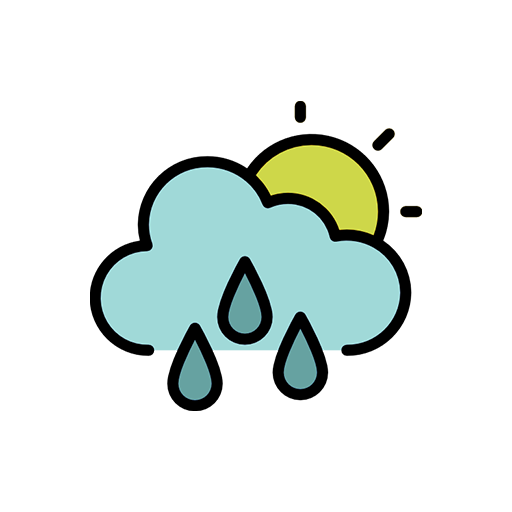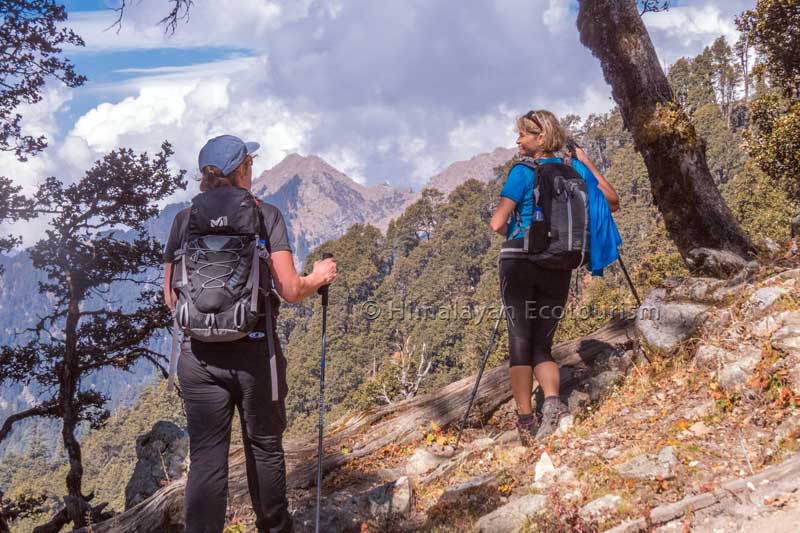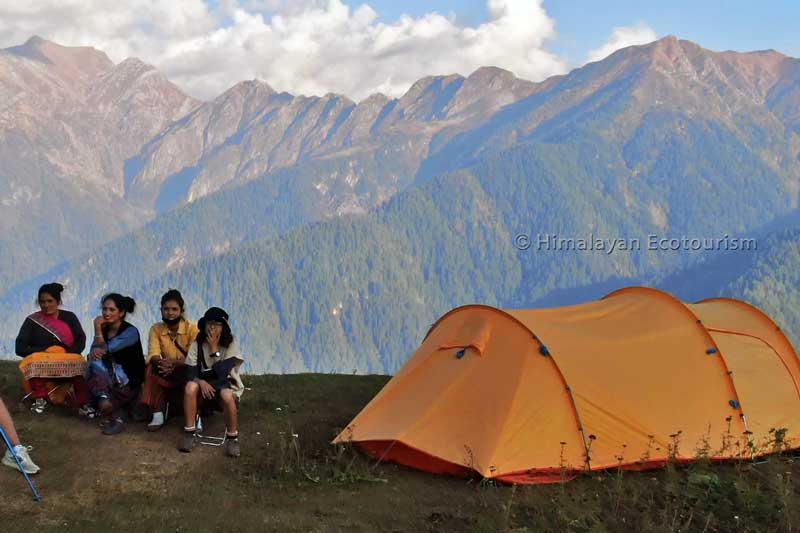Pangi Valley – Gift of the Gods & Kings
An introduction to Pangi Valley
“ पांगी देन है राजा की ” (Pangi is a gift from the king) believes Santosh and other locals residing in this beautiful valley. The locals express gratitude towards the King of Chamba and his predecessors who have over time provided the communities in Pangi with rations, infrastructure development and other gifts. The present government also sends rations and essential goods to the valley which the villagers need to stock as transport is cut off during winters owing to heavy snowfall. Pangi is not just a region, it is the combination of the land and the people.
Pangi is sandwiched between two magnificent mountain ranges, the Zanskar to the north and Pir Panjal to the south. Yes! You can trek from Pangi to Ladakh, if that’s what came to your mind after hearing Zanskar. A challenging feat and a treat for adventurous souls.
When we describe Pangi Valley as being a gift from the gods and kings, we refer to the natural beauty that is a gift from the gods and the established communities that are grateful to the kings.
What makes Pangi offbeat and Unique ?
Pangi Valley Tourism
Firstly, the terrain is extremely rugged and treacherous making it an adventurous journey for travelers to reach the villages in the valley. You may not be able to reach from point A to B in a split of a second unlike Delhi or the plains, but the journey will be an enriching experience. You will come across streams that fall off the edge of the mountain ranges and wash your car as you pass under them. The Chandrabhaga river cuts a deep narrow gorge that will give you goosebumps as you are on the edge of this gorge almost a thousand meters high above the river. The gorge as well as the surrounding terrain has a dense forest that contributes to pleasant weather most of the year.
Secondly, the warmth and hospitality of the locals adds to the experience. Locals treat guests in the utmost hospitable way and you will enjoy simple yet delicious meals. Mushroom, rajma, potatoes are common dishes served with rice, roti and dal. A special dish where they soak rajma in chang and cook it with mild spices is a must try. People have a simple lifestyle, most engaged in small-scale farming, grocery shops and small homestays. A few are professionals engaged in healthcare, teaching and govt jobs. Locals have a deep respect for their cultures and traditions, and they are always trying to ensure that their children learn and carry forward the traditions.
Then there is the unique geography. Now you will think every region has that, but what’s so special here ? Well! We are not using the adjective unique just because it’s a keyword. Pangi falls in the transition zone of the Himalayas and the Trans Himalayas, which makes Pangi Valley Tourism offbeat. Just imagine the flora and fauna you can experience in a region falling in the transition zone of two biodiversity rich zones.
Last but not the least, Pangi is not something that describes a single valley or a small geographical region that you can tick off your bucket list in a single visit. It comprises a vast region with sub valleys, each with its own magical experience. We definitely cannot sum up the Pangi Valley Tourism and the experiences here within a single page. Saichu, Miyar, Sural, Hudan, Parmar are some of the beautiful sub valleys, each offering a unique setting and adventure.
Travelling to Pangi Valley
How to reach Pangi Valley ?
Reaching Pangi Valley by Air
- The nearest airport is at Dharamshala (DHM), 180 km from Killar, Pangi Valley’s main town.
- Kullu Manali Airport (KUU), 230 km from Killar, is another option. Although, this airport is highly unreliable. Flights are delayed/cancelled on multiple occasions because of harsh weather
Reaching Pangi Valley by Rail
- The nearest railway station is Pathankot Railway Station in Punjab, 240 km from Killar.
Reaching Pangi Valley By Road
- Pangi Valley is connected to major towns via scenic routes. You can take either of the routes below to reach Pangi and plan your itinerary. If you have over a week, you can do a circuit trip through the Sach Pass
Route 1 : Kullu – Manali – Sissu – Udaipur – Purthi – Killar
This route is raw. When we say raw, we are referring not just to the road but also the food and stay options. On this route you will have to settle with limited options of basic food and stay, compromising slightly on your comfort zone.
Route 2 : Dharamshala – Dalhousie/Chamba – Tissa – Killar
We personally prefer this route if you plan to go and come back the same route. The reason ? You have beautiful spots to explore throughout the route. A good mix of monasteries and mountains. Enroute you have the chance to spend time at Khajjiar which is popular as Mini Switzerland. And of course, you cross the Sach Pass. You have more variety of food with good restaurants and comfortable stay options on this route.
The Tourism in Pangi Valley is still booming and there are many offbeat destinations where you can reach for a peaceful experience.
Best time to visit Pangi Valley ?
Pangi Valley weather
Pangi Valley’s weather is a symphony of seasons. Every time of the year paints a unique picture in the valley.
The showers in Pangi valley are very light, the valley receives precipitation predominantly in the form of snow from late October. You can trek/tour in the months from July to mid October, which is the peak season for Pangi Valley Tourism. Unlike other parts of the Great Himalayan National Park where you may not be able to trek from July to September.
Winters transform Pangi into a snow-kissed wonderland (November-March), with temperatures often below 0°C. Higher elevations receive heavy snowfall, while lower areas experience moderate snowfall. In the Pangi Valley, be prepared for temperature fluctuations and unpredictable changes at any time of the year.
Best Times to Visit Pangi Valley
The best time to visit this hidden gem depends on your heart’s desire.
The Pangi Valley is a seasonal odyssey. It is closed most of the year because of heavy snowfall. I recall how Santosh described the snowfall. He said, “I have to stack the wooden logs properly so I can find them when I come back after the winter. The stone walls we erect disappear almost every season after the heavy snowfall and avalanches. I have to build the dhaba foundation anew every year with the help of friends and neighbours”
Pangi Valley whispers secrets to those who dare to venture into its breathtaking landscapes. Beautiful secrets indeed! The dense vegetation, the river gushing through the magnificent gorge and the conversations with locals will reveal secrets that add treasure not to your bank account but definitely to your soul.
We recommend visiting Pangi Valley from July to September. This time of the year has the most pleasant temperature ranges. The valley comes alive in this short period of three months. The last wisps of snow kiss the hiking trails on higher altitudes. With each passing day the melting snow reveals a gorgeous blanket of vibrant wildflowers, transforming the meadows into a kaleidoscope of colors. The Sach Pass opens and unleashes a flurry of activity. Fruit harvest is in full swing, and the air is filled with the sweet scent of ripe fruit. The forests appear like a fresco of emerald green.
From November to May the Pangi Valley often records sub zero temperatures. June and October may also be considered if you don’t mind some cold temperatures.
Conquering the Sach Pass
The road to Sach Pass is narrow and unmetalled. You will have magnificent views throughout the journey. It is the shortest and the toughest route from Chamba to Killar. The pass is open only from early July to mid October.
Pangi Valley Temperature Chart
JAN
VERY COLD
Avoid
FEB
VERY COLD
Avoid
MAR
VERY COLD
Avoid
APR
VERY COLD
Avoid
MAY
COLD
Avoid
JUN
COLD
You may go
JUL
PLEASANT
Best time to go
AUG
PLEASANT
Best time to go
SEP
PLEASANT
Best time to go
OCT
COLD
You may go
NOV
COLD
Avoid
DEC
VERY COLD
Avoid
Moving in Pangi Valley
Transport during trip to Pangi Valley
Road Conditions in Pangi Valley :
The roads to Pangi Valley are challenging with steep inclines, rocky terrain, and occasional landslides. The breathtaking views of mountains, valleys, and rivers will make up for the treacherous roads.
Transport Options in Pangi Valley :
Public transport is a big no no for either of the routes unless you want a body ache and wouldn’t mind spending 8 hrs instead of 4 on the road. Reach out to us to curate the perfect itinerary with comfortable transport and reliable drivers.
HRTC buses ply on the routes but are highly unreliable. Hitchhiking options are available, but you never know how long you will have to wait until a shared jeep comes by.
Staying in Pangi Valley
Where to stay in Pangi Valley ?
Pangi Valley Accommodations
The towns and sub valleys in Pangi offer budget friendly homestay options with basic amenities and home-cooked healthy meals. There are also a few camps where you can choose to stay in tents. We advise the homestays as you have an opportunity to interact with locals.
Eco-Tourism Stays in Pangi Valley
There are a few Forest and PWD rest houses around Killar. These are somewhat unreliable as you may not be offered room incase there are administrative officers visiting last minute or incase of staff shortage
Where to stay in Dharamshala, Dalhousie and Khajjiar ?
These towns offer a wide range of stay and restaurant options. From luxury homestays to budget bed and breakfast.
Culture of Pangi Valley
Understanding Culture of Pangi Valley
When visiting Pangi, embracing local customs enhances your experience and shows respect for the region’s unique cultural heritage. Here are key cultural insights to consider:
- The local community was cut off from the other big cities for a very long time and they respect their culture and traditions and expect you to do the same
- “Atithi Devo Bhava” – People treat guests like god. Always greet the locals with smile, even if you are just passing by.
- Do not enter the kitchen and rooms with your shoes on. Where you are not sure, just ask the host.
Essential Tips for travelling to Pangi Valley
- Check weather forecasts before travelling.
- Ensure a full fuel tank at Chamba or Keylong.
- Carry essentials : food, water, first-aid kit, & warm clothing
- Do not rush. Allow your body to acclimate to high altitudes by taking appropriate stops enroute
- Respect the environment. Please do not throw trash out from your car window
Food of Pangi Valley
Pangi Valley’s cuisine is a delicious reflection of its Himalayan heritage, closely resembling the traditional Himachali cuisine. Local dishes are simple, wholesome, and infused with the region’s unique flavors.
Must-Try Delicacies in Pangi
Sidu (steamed bread)
Babru (Himachali flatbread)
Madra Rajma (kidney beans)
Kaddu Ka Khatta (pumpkin curry)
Akotri (buckwheat pancakes)
You may also want to try fish from the local street market in Chamba.
FAQ
What clothes should I bring to travel to Pangi Valley ?
The Pangi Valley is often cool and you will need a fleece in the early morning and late evenings no matter what month you are travelling in.
For colder months carry at least 3 layers. We also recommend a windbreaker and warm gloves when you plan to cross over the Sach Pass.
What SIM cards will work in Pangi Valley ?
Most sim cards work in the valley. Although, there are sub valleys and remote regions where you will be without connectivity. Be prepared to be out of network for a day or two at times.
Are there ATMs in Pangi Valley ?
Carry enough cash. There are very few ATMs in the remote parts and you will need cash. UPI may not work where you have zero internet connectivity. There are plenty of ATMs in Kullu, Dharamshala and Chamba enroute.
Other Pages about Himachal Pradesh
Multi-day treks
Meet the mighty Himalayas and explore GHNP’s wilderness on our 2- to 10-day treks.
Day hikes
Enjoy the Himalayan nature and quaint villages in one day with one of our day hikes.
Women treks
Join our women-only treks led by our women staff for camaraderie and adventure in the wild Himalayas.




















